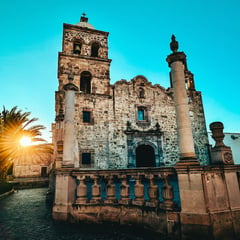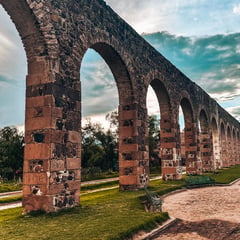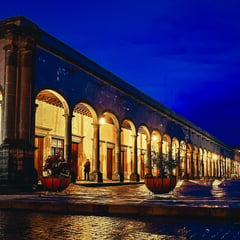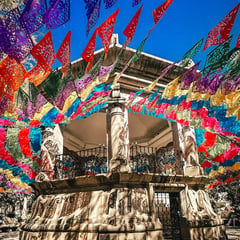History of La Bóveda
La Bóveda Hotel holds a history as rich as its structure, reflecting the resilience and elegance that have defined Nochistlán over the years. The building was constructed in the early 1800's serving originally as a mansion that also functioned as a vault for grains, beans, and other vital materials for the town. Not only were these raw materials stored onsite, but they were also processed into final products. During the Mexican Revolution, these resources proved to be fundamental for Nochistlán's survival amidst Mexico's widespread conflicts and challenges.
In 1913, the Nochistlán witnessed an act of bravery that still resonates in the town's memory. Between 80 and 90 Nochistlenses repelled an attack of approximately 500 men led by Leopoldo Arenal and Crispín Robles Villegas, both under the orders of Francisco "Pancho" Villa. Although Villa initially sought revenge, he was ultimately convinced not to retaliate. During the rest of Mexico's revolutionary period, Nochistlán remained unoccupied by any forces and lived a relatively peaceful, self-sustained existence.
Many years after the Revolution, the site no longer served as a vault and became a family residence. In the 21st century, this historic building was carefully renovated and transformed into a luxurious boutique hotel and event space. The space retains the charm of the past while offering guests a modern, comfortable experience. Here, history and luxury intertwine, offering a unique and unforgettable experience in the heart of Nochistlán, Zacatecas.
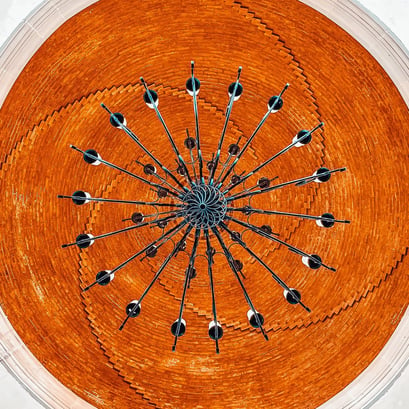

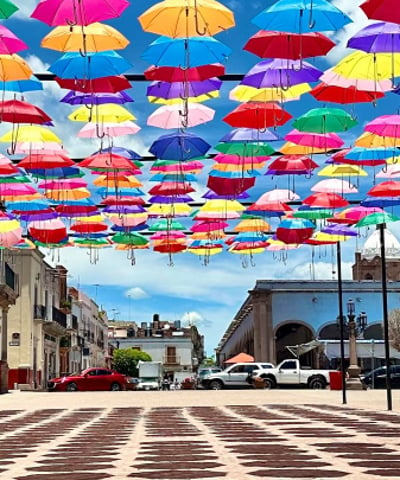

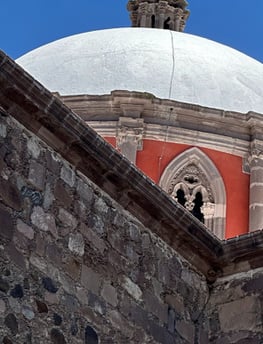

Nochistlán: Happy by Tradition
Nochistlán, Zacatecas, is a hidden gem full of history and culture that offers visitors a glimpse into the heart of Mexico. Founded in 1532 as the first "Guadalajara", this charming town is steeped in history, with cobblestone streets, adobe structures, and many well-preserved historic buildings that transport you back in time. Nochistlán, "The First Guadalajara" is recognized as one of Mexico's "Magical Towns" or Pueblos Magicos, a designation awarded to towns with exceptional cultural heritage, history, and unique charm. This one is romantic, charming, fun, and the most musical of all of Mexico's Pueblos Magicos.
Famous for its role in the Mixtón War, Nochistlán was a key stronghold. Led by Tenamaxtle, the Caxcan people ultimately revolted and drove Spanish forces inland to modern-day Guadalajara. Nochistlán's legacy is kept alive through historic sites such as the Temple of San Francisco, a majestic church with impressive baroque architecture that has stood the test of time. Additionally, the Parish of San Sebastián's immense, colonial tower stands tall through the skyline is a must-see. Another attraction is the Plaza de Armas, the heart and literal center of the town. The garden of the plaza, surrounded by historic buildings, invites you to enjoy a quiet walk, meet with friends, or enjoy music during Nochistlán's famous bohemian nights.
Nochistlán's Aqueduct, a major landmark, is a 16th-century engineering marvel that still stands today, reflecting the history and architectural skill of the time.
Nochistlán is known for it's happiness and famous for its vibrant festivals. particularly the Fiesta de San Sebastián in January, which fills the streets with music, dancing, and colorful processions. During the last weekend of every July, the town celebrates "El Hijo Ausente" or "The Absent Children". The streets are filled with carnival rides, processions, music, dancing, and parties, with the town celebrating the returning visit of her "absent children" who now live away. The October Fair is a month-long celebration that includes traditional bullfights, rodeos, folk dances, carnival rides, and parades that attract visitors from all over the world.
For those seeking outdoor adventures, the surrounding area offers stunning landscapes perfect for hiking and exploration. For example, "El Tuiche", a sacred hill in Caxcan culture, full of history, legends, magic, and mystery, offers visitors the chance to see ancient hieroglyphs and the best panoramic views of this Pueblo Mágico. Ceramic remains have been found dating from 300 to 900 AD. The Sierra de Nochistlán offers spectacular views and a serene escape into nature, ideal for disconnecting and enjoying the natural environment.
Whether you're drawn to the rich history, cultural celebrations, colonial architecture, or the quiet beauty of the countryside, Nochistlán offers an authentic Mexican experience that will make your stay truly unforgettable.
Points of Interest in Nochistlán
Temple of San Francis of Assisi: A majestic 17th-century temple dedicated to the patron saint San Francisco de Asís, where festivities in his honor fill the town with life every October.
El Parián: The commercial heart of Nochistlán, built in 1866, with its distinctive architecture of quarry columns and arches that invite you to explore the local culture.
Los Arcos Aqueduct: Completed in 1793, this aqueduct is one of the most iconic symbols of the town, with its impressive colonial stone arches.
Jardín Morelos (Main Square): The central meeting point, surrounded by historic buildings and with a beautiful kiosk, perfect for enjoying a quiet walk and enjoying the town's famous bohemian vibe.
Temple of San Sebastián: A 17th-century temple known for the "empinoladas," festivities in honor of San Sebastián every January.
Casa de Los Ruiz: A historic site where the first cry for independence was given in Zacatecas in 1810, marked by a commemorative plaque that remembers this heroic act.
Historical Monuments: Nochistlán is full of monuments that reflect its rich history, such as the Statue of José Minero Roque and the Monument to the Heroes of 1864, each representing key moments in the town's history.
These points of interest, along with the warm hospitality of La Bóveda Hotel, make Nochistlán an ideal destination for those looking to immerse themselves in Mexican charm and history.
